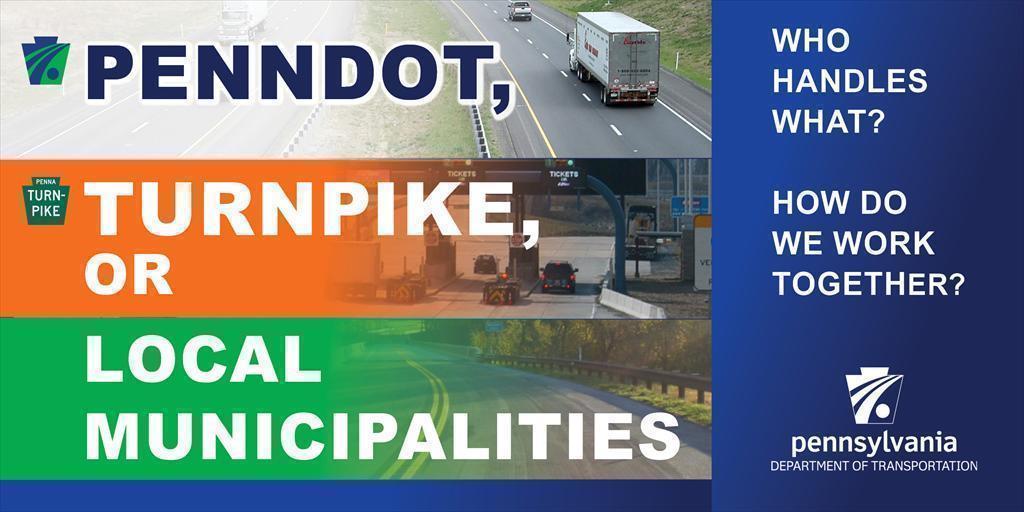
What is the difference between PennDOT, PA Turnpike, and Local Municipalities?
The Pennsylvania Department of Transportation (PennDOT)
 PennDOT was established in 1970 and oversees transportation issues in the Commonwealth of Pennsylvania. The administrator of PennDOT is the Pennsylvania Secretary of Transportation, currently Leslie Richards. PennDOT supports over 40,000 miles of state roads and highways, about 25,000 bridges, as well as new roadway construction.
PennDOT was established in 1970 and oversees transportation issues in the Commonwealth of Pennsylvania. The administrator of PennDOT is the Pennsylvania Secretary of Transportation, currently Leslie Richards. PennDOT supports over 40,000 miles of state roads and highways, about 25,000 bridges, as well as new roadway construction.
PennDOT also oversees motor vehicle safety & licensing, and driver licensing. It administers the state's more than 11 million vehicle registrations and 8.8 million driver's licenses, and oversees safety and emission inspection programs. To learn more about Driver & Vehicle Services visit www.dmv.pa.gov.
Among some other sources, PennDOT is supported by the motor vehicle fuels tax which supports functions related to highway and bridge work. Though there is occasionally the opposite misconception, revenues in the Motor License Fund cannot be used on transit.
The Pennsylvania Turnpike
Local Municipalities
How does PennDOT, PA Turnpike, and Local Municipalities work together?
ABOUT THIS BLOG
Did you know PennDOT is directly responsible for nearly 40,000 miles of highway and roughly 25,000 bridges? We oversee programs and policies affecting highways, urban and rural public transportation, airports, railroads, ports and waterways, in addition to administering the state's more than 11 million vehicle registrations and 8.8 million driver's licenses.
So, how do we do what we do? And how can we help you travel in Pennsylvania — whether it be for business or leisure — in safe and enjoyable manner? Read PennDOT Way to learn more about the department, what we do, and how and why we do it.
TAGS
50-Year Anniversary, 511PA, Aggressive Driving, Airports, Autonomous Vehicles, Bicycles, Bridges, Child Safety, Community Relations, Construction, COVID-19, Distracted Driving, District 1, District 10, District 11, District 12, District 2, District 3, District 4, District 5, District 6, District 8, District 9, DOTcom, Driver and Vehicle Services, Emergency Responders, Employment, Equity, FAQ Friday, Human Trafficking, Impaired Driving, Innovations, Live Free Ride Alive, Maintenance Monday, Motorcycles, Older Drivers, PA Motorcycle Safety Program, Pedestrians, PennDOT Connects, Ports, Public Transit, Railroads, REAL ID, Road MaP, Roadside Beautification, Rural Roads, Safety, School Buses, Seat Belts, State Transportation Innovation Council (STIC), Sustainability, Teen Drivers, Throwback Thursday, Transportation Funding, Travel in PA, Welcome Centers, Winter, Work Smart, Work Zone, Yellow Dot
LATEST POSTS
PennDOT Continues Sharing, Updating Resources for Local Governments to Pursue Bipartisan Infrastructure Law Funding Opportunities
Norwin High School Wins 2024 ‘Innovations Challenge’
Demo Complete: I-95 CAP Project in Center City Philadelphia
PennDOT Archeologist Connects Past, Present, and Future
Lehigh Valley DUI, Highway Safety Task Force Hosts Law Enforcement Seminar
ARCHIVES
2024
2023
2022
2021
2020
2019
2018
2017

